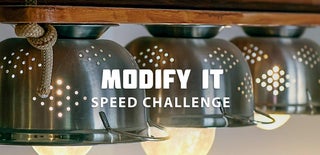Introduction: A Suitcase From Jerry Can
It is no matter your profession or your age, this suitcase from a jerrycan will ensure that you travel in style.
How I did it - you can check by looking DIY video or you can follow up instructions below.
For this project you will need:
Materials:
Jerry Can;
Butterfly latch: https://bit.ly/3drZPc1
Rubber Edge Seal 3m: https://goo.gl/ryXLwD
Pair of hinges;
Pop rivets for hinges and latch;
An old suitcase to reclaim a Trolley Folding Handle Mechanism;
M4 bolts and nuts;
5min epoxy (or another fast curing epoxy);
The spray can paint to change internal Jerry Can color (if wanted);
A similar shade of green paint to paint visible edges where metal will be exposed;
Masking tape and few pieces of cardboard;
Tools:
The angle grinder;
File, power file, or another tool to clean burs after the cut.
Drill and bits;
Pop rivets tool;
Screwdriver;
Utility knife;
Clamps and some other usual bits and bobs which is laying around the workshop.
Step 1: Preparation
Back in a few years I used a Jerrycan in another project and transformed it into a minibar (How I did that DIY video CLICK HERE). Since that day I kept another idea in my mind which today will see the daylight.
First I covered both jerrycan sides with a piece of the cardboard to protect the surface from scratches along the fabrication process.
Step 2: First Cut
Next split the can in half. In the place where the angle grinder wasn’t able to reach - I finished the cut with a rotary tool.
Step 3: More Cutting
When the cut was done one part still has this pressed metal edge which must be removed.
Step 4: Cleaning All Sharp Edges
To clean all sharp edges I used my homemade power file. This is a very useful attachment to the angle grinder which I build recently. Here is the link to full DIY build video CLICK HERE.
Step 5: Rubber Edge Seal
To cover all edges I used this rubber edge seal. It is flexible and nicely bends over the corners. I bought it locally, but CLICK HERE to get the equivalent product. Just in case if you want to get it online.
Installation is very simple - just pressed it on the metal edge.
Step 6: The Hinges
I’m planning to use those small hinges, so marked and drilled holes for rivets. A bit of trimming was needed to get a nice and tight fit.
I fixed the hinges temporarily with bolts and nuts because I will need to disassemble it again. I want to paint it inside when all metalwork will be done.
Step 7: The Butterfly Latch
To keep the suitcase closed and secured I’ll use this butterfly latch. This type of latch is commonly used in heavy-duty music equipment transportation boxes. I’m my case I don’t need much holding power, but it looks cooler than standard latches.
To make marking easier I made a simple template from a piece of cardboard. And the rest part of the job was made by an angle grinder, rotary tool, and a drill.
Step 8: A Bit of Painting
Since all metal works were completed - it was a perfect time to change the internal suitcase color.
The rest of the open metal edges were covered with a similar shade of green paint. A small detail, but it makes a big difference in the finished item.
Step 9: Installing Hinges
Hinges were installed permanently with the pop rivets painted in green. The color wasn't exactly the same tone, but it was quite close.
Step 10: Installing the Butterfly Latch
The butterfly latch was fixed in the same technique. The only difference was that this time I added a washer on the opposite side to achieve more strength.
When all rivets were fixed I reinstalled the rubber edge seal.
Step 11: Reusing Parts From Old Suitcase
I borrowed a Trolley Folding Handle Mechanism from this suitcase.
Step 12: Fixing Bottom Part
Removed cardboard protection from the back of a Jerry Can, found the right place for it, marked, drilled, and attached it with few pop rivets.
Step 13: Fixing Upper Part
With the upper part, I needed to disassemble the handle a bit to get access to install the third pop rivet.
Step 14: Fixing the Second Bottom Part
Lastly installed the second bottom stand part. Since it has to act as support only a bit of modification was needed.
Step 15: Removing Cardboard Protection
This cardboard did its job very well, not a single scratch was left.
Step 16: Finished Product
Ye ye, I’m guessing you all are saying that: “There no way you’ll be able to get in the plain with this suitcase”.And you will probably be right. However, I could use it everywhere else. And what is most important - It definitely pops out from the mass of others.

First Prize in the
Modify It Speed Challenge











